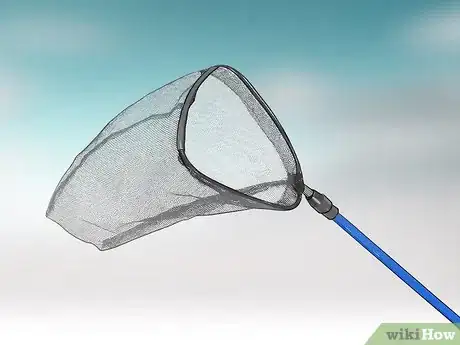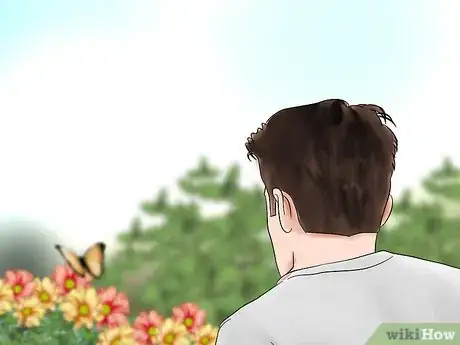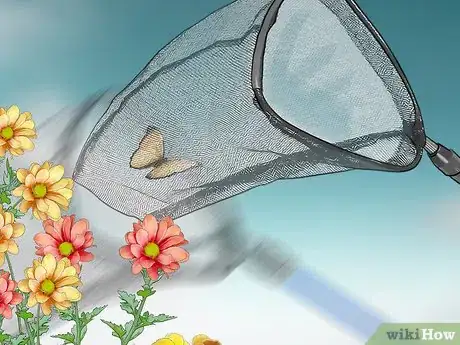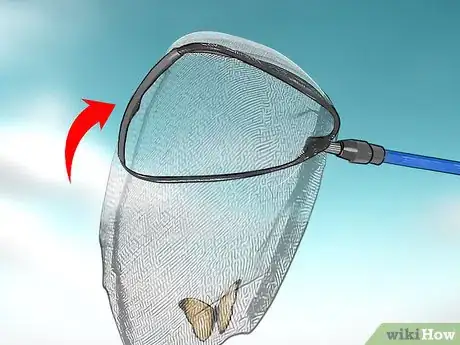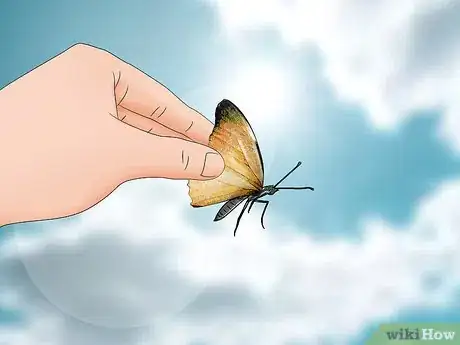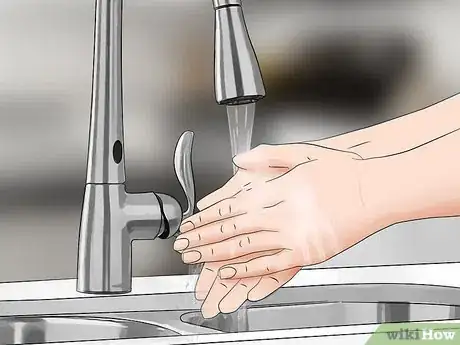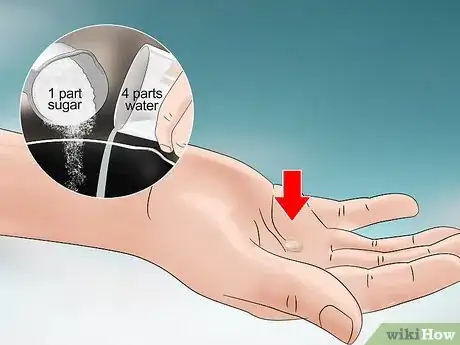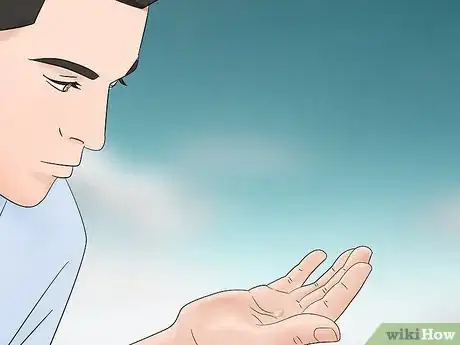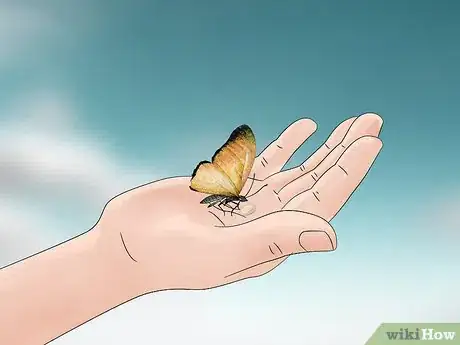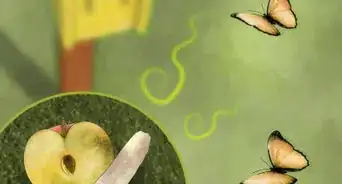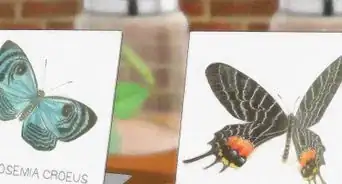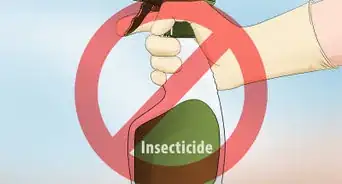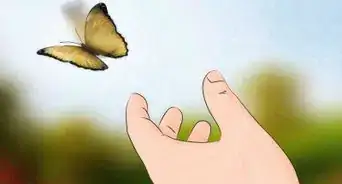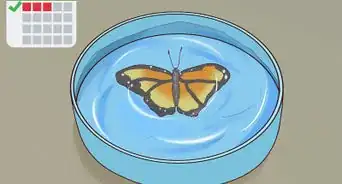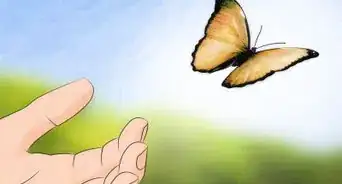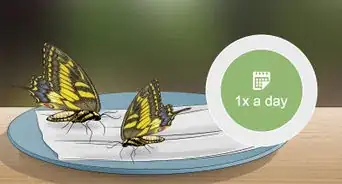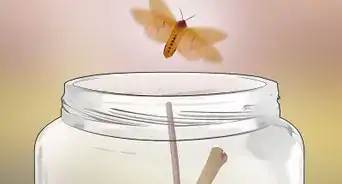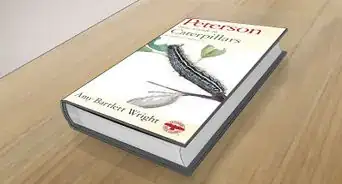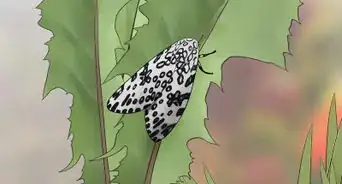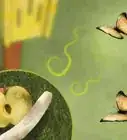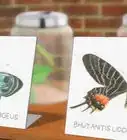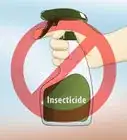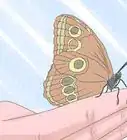This article was co-authored by Shweta Sharma. Shweta Sharma is a Biologist with the U.S. Environmental Protection Agency (EPA). With nearly ten years of experience, she specializes in insect management, integrated pest management, insect behavior, resistance management, ecology, and biological control. She earned her PhD in Urban Entomology and her MS in Environmental Horticulture from the University of Florida. She also holds a BS in Agriculture from the Institute of Agriculture and Animal Sciences, Nepal.
There are 7 references cited in this article, which can be found at the bottom of the page.
This article has been viewed 46,205 times.
Getting the chance to hold a butterfly is a truly magical occurrence. They are shy creatures, so you should consider yourself lucky if you get one to stay on your hand. Finding and catching one may be tricky, but a fun experience overall. Handling butterflies to look at them closely, in all their beauty, requires a gentle and caring approach.
Steps
Finding a Butterfly
-
1Search in the summer during the daytime. Butterflies tend to be more active when it is sunny, and summertime is butterfly season (between May-August). So when you’re looking for butterflies, go in the morning or early evening when it’s not too hot.
- In the morning or early evening, butterflies will sit with their wings spread out to absorb the sunlight. Once they are warmed up, the butterflies will start to fly around and find food.[1]
- Keep in mind, butterflies won’t fly if the temperature is less than 60 degrees.[2]
- Be careful - there are certain species of butterflies that could be endangered or harmful and should not be handled.
- Keep in mind of any allergies you may have (e.g allergies to pollen...)
-
2Go to an area with bright-colored flowers and fruit. Butterflies have a sweet tooth. You will find them in places where there are an abundance of flowers, as they use them for their nectar. Regular spots to find lots of flowers include botanical gardens, parks, meadows, and butterfly groves.
- Search in an area with bright colors. Butterflies tend to be seen around red, yellow, orange, pink, and purple blossoms.
- Look for the following plants that various species of butterfly tend to enjoy: daylily, marigold, oregano, lavender, goldenrod, sage, fennel, and others.[3]
- Butterflies also enjoy fruits, so you can find them by citrus trees or blackberry plants.[4]
Advertisement -
3Visit your local zoo. You may not be able to find any butterflies due to the area you live in or the weather. Luckily, many zoos have butterfly exhibits where visitors can get a close-up view of various butterfly species.
- Always follow the rules and guidelines at the exhibit. Although you may not be permitted to touch the butterflies at the zoo, there is a chance that one lands on you so you can observe them up close and personal.
Catching a Butterfly With a Net
-
1Obtain a net to catch a butterfly. You can purchase a net or make one using a wooden handle, a wire hanger, duct tape, and netting. The net should be at least 24 inches (2 feet) deep, allowing you to trap the butterfly in the deep end of the net.
- Avoid purchasing a cheap “children’s” butterfly net. The shallow netting may harm the butterflies.
- Research the laws in your area regarding butterfly hunting. In some cities, you may need a permit to carry a net. You can find this information by doing a quick Google search of "butterfly net laws" along with the name of your city and state.[5]
-
2Slowly approach the butterfly from behind. Butterflies can be skittish and will scare easily, so it’s best to approach one from behind where they won’t see you. For best results, sneak up on one that is resting on a flower. It will be harder to catch one while it is in mid-flight.
-
3Catch the butterfly in the bottom of the net. To catch the butterfly, do a quick scoop to surround the butterfly with the net. Move your net so that the butterfly is at the deep end of the net, not toward the top rim.
-
4Flip the net over the handle. Once the butterfly is in the deep end of the net, flip the netting over the handle so there are no open holes. This will prevent the butterfly from escaping back through the hoop.
-
5Get the butterfly out of the net with both hands. Now it’s time to get the butterfly out of the net without it flying away. Do this very gently, as to not damage the insect’s body, legs, or wings.
- Carefully flatten the net bag so that the wings of the butterfly are closed over its back. From the outside of the net, use your thumb and forefinger to hold the top part of the wings.
- With your other hand, use your thumb and forefinger to firmly grasp all four wings, then carefully remove it from the net.
- Try holding the butterfly upside down; that will calm it down.[6]
Handling a Butterfly
-
1Wash and dry your hands. Although butterflies are very resilient creatures, chemical contact with their scales, wings, and bodies should be avoided. Whether you catch your butterfly with a net or are lucky enough to have one land on you independently, you need to make sure your hands are clean and dry before touching it. So if you put on any sunscreen or bug spray before you went off to catch your butterfly, wash your hands to get that residue off before touching them.[7]
-
2Use sugar water to attract the butterfly to your hand. You may be able to get a butterfly to land on you without trapping it in a net by making butterfly nectar, which is a sugar and water mixture. You can make butterfly nectar by boiling a solution of 4 parts water and 1 part sugar. While observing butterflies near flowers or plants, put a little bit of the sugar water on your hand. They are attracted to the mixture and may fly to your hand to feed.[8]
- Don't add any coloring to your sugar water mixture.
-
3Remain very still. Butterflies are very skittish and will scare easily. If you want one to land on your hand and stay there for a while, you need to be still and avoid any sudden movements.
- If you put sugar water in your hand, butterflies will usually feed for 30 seconds to a minute before flying away again.[9]
-
4Be careful when handling. While the butterfly is sitting on your hand (or wherever it decided to land), avoid petting it. Just try to observe its beauty without touching.
- Butterfly’s wings are covered in tiny scales. These scales give them their wing patterns, and make them more aerodynamic when flying. When you touch their wings, they lose scales. If they lose these scales, they can still fly. However, depending on the number of scales lost, it may make them less aerodynamic and can affect their flight pattern slightly.[10]
Expert Q&A
-
QuestionHow do you differentiate a butterfly from a moth?
 Shweta SharmaShweta Sharma is a Biologist with the U.S. Environmental Protection Agency (EPA). With nearly ten years of experience, she specializes in insect management, integrated pest management, insect behavior, resistance management, ecology, and biological control. She earned her PhD in Urban Entomology and her MS in Environmental Horticulture from the University of Florida. She also holds a BS in Agriculture from the Institute of Agriculture and Animal Sciences, Nepal.
Shweta SharmaShweta Sharma is a Biologist with the U.S. Environmental Protection Agency (EPA). With nearly ten years of experience, she specializes in insect management, integrated pest management, insect behavior, resistance management, ecology, and biological control. She earned her PhD in Urban Entomology and her MS in Environmental Horticulture from the University of Florida. She also holds a BS in Agriculture from the Institute of Agriculture and Animal Sciences, Nepal.
Biologist Moths are usually hairy, thicker bodied and less vibrant whereas butterflies are more smooth, lean bodied and vibrant colored. Also, moth's wings lay flat against their bodies when resting, while butterflies fold their wings on their back when resting.
Moths are usually hairy, thicker bodied and less vibrant whereas butterflies are more smooth, lean bodied and vibrant colored. Also, moth's wings lay flat against their bodies when resting, while butterflies fold their wings on their back when resting. -
QuestionWhat if my garden is full of bees and wasps? The bees and wasps will be attracted to nectar, pollen, and light colors.
 Community AnswerYou could try to place wasp traps around your yard, you can either buy one or make one. Homemade ones usually contain some kind of sweet liquid. Keep in mind that bees are great for your flowers (and not to mention your or your friend's gardens), and they are a major contributor in food production. I wouldn't suggest trapping the bees if you can help it.
Community AnswerYou could try to place wasp traps around your yard, you can either buy one or make one. Homemade ones usually contain some kind of sweet liquid. Keep in mind that bees are great for your flowers (and not to mention your or your friend's gardens), and they are a major contributor in food production. I wouldn't suggest trapping the bees if you can help it. -
QuestionHow do I handle a butterfly?
 Community AnswerPut a leaf inside the container. Wait for the butterfly to move onto it, then slowly take the leaf out, Gently hold the tip of the butterfly's wings, so that it cannot fly away. Be very careful when holding the wing. One slip up, and the butterfly's wing will be crumpled or torn.
Community AnswerPut a leaf inside the container. Wait for the butterfly to move onto it, then slowly take the leaf out, Gently hold the tip of the butterfly's wings, so that it cannot fly away. Be very careful when holding the wing. One slip up, and the butterfly's wing will be crumpled or torn.
Warnings
- Make sure you are being gentle when holding the butterfly. You do not want to accidentally pull off the butterfly's legs or wings, resulting in physical damage to the butterfly and mental damage to you.⧼thumbs_response⧽
Things You'll Need
- Sugar water (butterfly nectar)
- Butterfly net
Expert Interview

Thanks for reading our article! If you'd like to learn more about butterflies, check out our in-depth interview with Shweta Sharma.
References
- ↑ https://frogmom.com/where-to-see-butterflies-in-nature/
- ↑ https://texasbutterflyranch.com/2012/09/04/butterfly-faq-how-to-tag-a-monarch-butterfly-in-six-easy-steps/
- ↑ https://www.gardeners.com/how-to/attracting-butterflies-hummingbirds/7265.html
- ↑ https://frogmom.com/where-to-see-butterflies-in-nature/
- ↑ https://www.fs.usda.gov/detailfull/mbs/home/?cid=fsbdev7_001600&width=full
- ↑ https://texasbutterflyranch.com/2012/09/04/butterfly-faq-how-to-tag-a-monarch-butterfly-in-six-easy-steps/
- ↑ https://texasbutterflyranch.com/2012/09/04/butterfly-faq-how-to-tag-a-monarch-butterfly-in-six-easy-steps/
- ↑ https://learning-center.homesciencetools.com/article/make-butterfly-feeder/
- ↑ https://frogmom.com/where-to-see-butterflies-in-nature/



